COMMENT: Is the worst over for the Singapore economy?

By Cai Daolu
SINGAPORE — Singapore’s economy entered a technical recession with a record contraction in the second quarter. According to the Ministry of Trade and Industry advance estimates based on the first two months of the quarter, gross domestic product fell by a record 41.2% on a quarter-on-quarter annualised basis.
The record double-digit contraction shouldn’t come as a surprise to anyone as Singapore enacted social distancing measures during the circuit breaker period from 7 April to 1 June.
Construction activity was completely paralysed shrinking by 95.6 per cent, while manufacturing output dropped by 23 per cent on an annualised basis from the previous quarter.
In the times of pandemic, uncertainty abounds. However, it is very unlikely that the current contraction will continue for the rest of the year. Unless we see a third wave, fourth wave for the remaining part of the year and lock down again, economic activity should pick up.
There are reasons to be optimistic that the current drop marks the bottom of the recession. First, the economic damage of the second quarter was a direct consequence of implementation of the Circuit Breaker measures, which includes the suspension of non-essential services and workplaces. As Singapore relaxes the restrictions of the circuit breaker, economic activity will consequentially rebound, providing that there is no further outbreak of the virus in the community in the near future.
Second, public health officials have more data today than at the beginning of the outbreak of Covid-19 on the nature of the virus. There’s still hope for effective therapy and vaccinations.
In addition, external demand will likely be boosted when we see recovery in global economic activity, particularly in the US and in China. Singapore’s total exports in June fell by 9.3 per cent on a year-on-year basis. Most of this drop is due to falling exports to main markets, including Hong Kong, China and the European Union. With the gradual lifting of containment measures in the rest of the world, we will expect a rising demand for Singapore exports.
Investment and economic activities will rebound if economic agents are confident that policy makers can contain the spread of the virus so that there is no further outbreak — on this front, a transparent and efficient government is essential. A speedy recovery requires that households have full confidence to go back to work, study and play safely.
To save the economy, we need to save lives. In other words, there is no tradeoff between these two choices in the current pandemic. It’s a win-win situation.
Even if the worst has not materialised, there is still policy room for macroeconomic policy makers in Singapore to mitigate the impact of a severe recession. Aggressive fiscal stimulus and liquidity policy may help to reduce risks of bankruptcy cascades for the near future to come.
This current plunge is a natural outcome of a much-needed temporary lock-down measure to curtail the spread of the COVID-19 virus. The road ahead is albeit treacherous but if there is policy inaction and an ineffective government, the economic result would have been much worse.
Dr Cai Daolu is a Visiting Senior Fellow at NUS Business School's Department of Strategy and Policy. The opinions expressed are those of the writer and do not represent the views and opinions of NUS.



